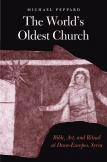New Readings of Old Art
Step back to a town with a sizable Roman garrison holding the eastern front along the Euphrates River in the early to mid-third century of the Christian Era. Who would not jump at the chance to accompany the catechumen Isseos through the sacred rites of Christian baptism? Or to wonder about others whose names appear connected to the artistic decoration of the baptistery? We meet a soldier named Pontus who commissioned a David slaying Goliath, and a woman named Hera attached to female figures in a torchlight procession toward a mysterious building. Michael Peppard, professor of theology at Fordham, takes readers on this journey in this well-illustrated volume.
Peppard notes small details in the artistic program of the Dura house-church complex that reflect life in this frontier town. The main assembly hall contains an armored lancer, who may have represented the feared (or admired) Persian forces just across the river. David with his sling might have brought to mind the Roman ballistics, “the slingers,” once used against Persian archers. As other elements of the artistic program suggest, Christians looked to their God for protection and strength in this dangerous world.
While most people today imagine a terrified Peter sinking into storm-tossed waves, the Dura baptistery has a very different image of Peter walking on water. He strides securely from the boat toward Jesus while the others look on. Peppard confirms this understanding of the image as a confirmation of Peter’s faith, with other examples from Syrian Christianity including Ephraem’s commentary on the Diatessaron and the Odes of Solomon.
The caution Peppard expresses about using other sources disappears in subsequent chapters. Later artistic and textual evidence, some of it without any more Syrian provenance than a passing scholarly conjecture, is drawn into the fray when Peppard launches a full-court press against the common interpretation of two central images—the women with torches and the woman drawing water from a well. His revisionist proposals are familiar to scholars and have even garnered enough support that visitors to the newly renovated gallery at Yale will find a neutral placard attached to the women processing with torches. The original identification with the women visiting the tomb of Christ seems problematic. Neither the Gospels nor apocryphal traditions have the women bringing torches.
Peppard prefers the parable of the wise and foolish virgins (Mt 25:1-10), from which he will proceed to elaborate an interpretation of the pre-baptismal anointing typical of Syrian initiation as part of the wedding between the initiate and Christ, the bridegroom.
In the case of the woman drawing water from the well, Peppard has to reach even further afield in later Christian artistic representations to support the revisionist conjecture that it represents a scene of the Annunciation to Mary, not the Samaritan woman of John 4. One can build up quite an archive of images in which the Virgin, having gone to draw water, looks back over her shoulder toward Gabriel. Perhaps lines on the wall indicate another figure.
But to explain what may be a five-pointed star on the woman’s garment as “the spark of incarnation in the body of the Virgin,” with modern icons as the immediate supporting evidence, is a stretch too far. Furthermore, the hairstyle of the woman at the well is that of the other women figures, without any distinguishing nimbus or crown. Peppard explores a number of other Annunciation scenes, some focusing on the rope in the well, others on the Virgin spinning. That chapter presents a fascinating history of an artistic trope but also marks a detour away from Dura. And the detour turns into a pilgrimage as another collection of items brought back by pilgrims to Syro-Palestine is introduced as evidence for the ubiquity of Annunciation scenes. And, as Peppard did in the case of the women bearing torches, he then spins out an additional narrative. Mary as the “well” becomes the “womb,” with additional texts to elaborate a Syrian mysticism focused on initiation as “new birth.”
We lose touch with our catechumen, Isseos, in these final two chapters of revisionist art history. The attentive reader who compares these roughly executed Christian figures, though not dissimilar from some of our earliest catacomb art, with the far richer art of the Dura synagogue may wonder if Isseos, Hera or Proclus saw anything of this elaborate web of symbolism on their walls.
Still, Peppard poses an important challenge to conventional liturgical histories in pointing out that this artistic program has a rich concept of salvation that is not at all related to the baptism into the death and resurrection of Christ from Romans 6. He has proposed an interesting methodological approach to open up the resources of early Christian art that challenges viewers to reflect on the lived experiences of this small community in a garrison town.
The author writes with admirable clarity, so the non-specialist should not be deterred by the thicket of evidence aimed at Peppard’s academic colleagues. The illustrations, plates and line drawings allow readers to see what is being described. The rich detail is fascinating in its own right. And today’s catechumens will also enjoy a glimpse of the Easter mysteries in a world far away. But one also leaves a bit saddened to contemplate the contemporary destruction of Syria’s rich Christian heritage.
This article also appeared in print, under the headline “New Readings of Old Art,” in the August 15-22, 2016, issue.








